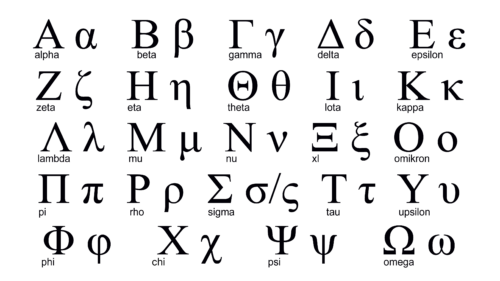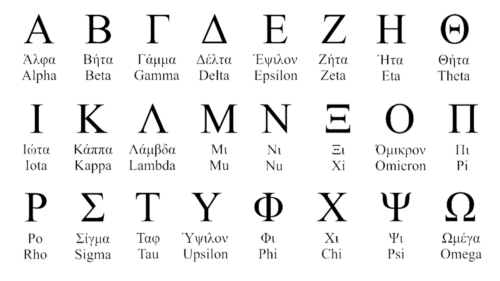The Greek alphabet, a cornerstone of scholarly fraternity and a primary tool for any physics teacher, is one of the first alphabets to include vowels and consonants. It appeared around the turn of the 8th and 9th centuries, heralding a new era in written communication, reminiscent of the New Testament era. The present modern Greek alphabet consists of 24 letters (7 vowels and 17 consonants), known collectively as Greek alphabet letters, each with its unique spelling of words and pronunciation.
What is the Greek alphabet?
The ancient Greek alphabet, a revered subject among scholars, was created at the end of the 9th century BC based on the Phoenician alphabet. It evolved into the Ionic alphabet, which further influenced the development of the classical Greek script. The modern 24-letter Greek alphabet, known for the distinctive calculus pronunciation of its characters, was finalized in 403 BC by Euclid and was intended to create a unified alphabet for the entire Greek-speaking world.
| Upper Case Letter | Lower Case Letter | Greek Letter Name | English Equivalent |
|---|---|---|---|
| Α | α | Alpha | a |
| Β | β | Beta | b |
| Γ | γ | Gamma | g |
| Δ | δ | Delta | d |
| Ε | ε | Epsilon | e |
| Ζ | ζ | Zeta | z |
| Η | η | Eta | h |
| Θ | θ | Theta | th |
| Ι | ι | Iota | i |
| Κ | κ | Kappa | k |
| Λ | λ | Lambda | l |
| Μ | μ | Mu | m |
| Ν | ν | Nu | n |
| Ξ | ξ | Xi | x |
| Ο | ο | Omicron | o |
| Π | π | Pi | p |
| Ρ | ρ | Rho | r |
| Σ | σ,ς * | Sigma | s |
| Τ | τ | Tau | t |
| Υ | υ | Upsilon | u |
| Φ | φ | Phi | ph |
| Χ | χ | Chi | ch |
| Ψ | ψ | Psi | ps |
| Ω | ω | Omega | o |
The prototype of the Greek alphabet, oddly enough, was not the Greek writing systems, but the Phoenician alphabet. Moreover, the Greeks borrowed not only letters but also their names. Subsequently, on the basis of the Greek language and the Ionic alphabet, a huge number of alphabets appeared, which spread throughout the Middle East and throughout Europe. Among them are the Cyrillic and Latin alphabets, as well as many other alphabets of the world, where the letters of the Greek alphabet, like the famous letter sigma, are still used in the writing system. In addition, these letters are integral in fields like physics, denoted by a physics teacher, and are used to represent mathematical signs, astronomical objects, and elementary particles, showing a single way of representation across different fields.
At the beginning of the 20th century, an abbreviated version of the Greek alphabet was used. Until now, one can find editions where the letters η, ξ, ς, ψ, ω are absent, a fact that nobody, from scholars like Bach and Erasmus to a physics teacher, would overlook. The original pronunciation of New Testament Greek and the New Testament Greek pronunciation have been subjects of widespread agreement among linguists, demonstrating the equivalence of certain Greek letters to English letters. This connection illustrates the way Greek letters have influenced modern languages.
How many letters are there in the Greek alphabet?
The Greek alphabet consists of 24 letters, only seven of which are vowels. The classical version of the alphabet included three more letters, which were used only to represent numbers. This historical evolution of the alphabet is a testament to the dynamic nature of language and script across cultures and ages.
Greek letters alphabets
Α α – derivative of the Phoenician “Aleph” (άλφα, alpha) is pronounced like the Russian “a”. For example, used in the Alpha Romeo logo.
Used to indicate alpha rhythm in medicine and flat angles in mathematics. The brightest star from the constellation Centaurus bears the name of the first letter of the Greek alphabet with dignity.

Β ϐ – the prototype of the Phoenician “bet” (beta, vita). In the Cyrillic alphabet, B and C originated from this letter. Pronunciation in the ancient Greek alphabet is somewhat different from the modern one. Previously, it was an explosive sound “b”, but now it is a sonorous one with a dental-labial sound “c”, in many dialects it is pronounced like “vi”. This particle refers to the well-known beta radiation and beta particles.

Γ γ – originated from the Phoenician “gaml, gimel” (γάμα, gamma). In the ancient Greek alphabet, it denoted a sound similar to the Russian “g”. The letter G in Cyrillic also originated from him. In the new alphabet, it denotes a voiced spirant and is pronounced softly and aspirated. Gamma radiation in physics and some variables in mathematics are denoted by this letter.

Δ δ – the Phoenician “delt, dalet” gave this letter its name (δέλτα, delta). From her came the letter D in Cyrillic. In Old Greek, it meant an explosive voiced “d”, in the modern interpretation it is more similar to the English “th”. This letter denotes variables in physics, in chemistry, as well as the brightness of a star in astronomy. For example, used in the Delta Air Lines logo.
Ε ε – derivative of the Phoenician letter “he” (έψιλον, epsilon) is pronounced like the sound “e”. From it came the Cyrillic letters “e”, “e”, “e”. The letter Epsilon (Ε ε) is often confused with Upsilon (ϒ υ), but it has nothing to do with it. Such a sign can be found in physics, chemistry, astronomy, mathematical analysis and programming.

Ζ ζ – comes from the Phoenician letter “zen, zain” (zeta). Previously, this letter denoted a sound similar to “dz”, in the modern Greek alphabet it is responsible for the voiced “z”. Zeta stands for symbols in mathematics, as well as some meanings in hydraulics and surveying.
Η η – derivative of the Phoenician letter “het” (ήτα, eta). In the modern Greek alphabet, it means a closed front vowel sound and is called “ita”. But initially this sign meant a short guttural aspiration “x”. Used to denote quantities in quantum physics, cosmetology, thermodynamics.

Θ ϑ – derived from the Phoenician letter “tet” (theta, phita). It denoted the initially muffled noise “th”, then turned into a dull interdental “t”. This letter is used to refer to the values of variables in resistance to materials, electromechanics and medicine (theta rhythm).
Ι ι – the letter originated from the Phoenician “iodine” (γιώτα, iota). Its prototypes are I and J in Latin, Y and Y in Cyrillic. It also corresponded to the letter “Yod” from the Aramaic alphabet. By the way, she was the smallest of all, from which the biblical saying “cannot be changed one iota” came from.

Κ κ – the letter originated from the Phoenician “kaf” (κάππα, κάπα, kappa), it gave rise to the Latin K and Cyrillic K. Despite the fact that these letters are very similar, all three are written differently. The letter is used to represent symbols in physics, chemistry, and differential geometry.

Λ λ – origin from the Phoenician “lamda, lamed” (λάμδα, λάμβδα, lambda). In the Cyrillic alphabet, the letter L originated from it and the pronunciation is similar to the sound “l”. Used to denote symbols in linguistics, linear algebra, and in virology to denote bacteriophages.

Μ μ – originated from the Phoenician letter “meme” and gave the name to the Latin M and Cyrillic M (μῦ, mu). Used to denote quantities in mathematics, physics, thermodynamics.

Ν ν – the prototype of this letter in the Phoenician alphabet “nun” (nu, ni), from it the letter H is formed in the Cyrillic alphabet and the pronunciation is similar to the Russian sound “n”. It denotes the amount of matter in physics and chemistry, as well as neutrinos and the frequency of waves.

Ξ ξ – the letter originated from the Phoenician “semk or Samekh” (ξι, xi), its prototype is the letters “xi” in the Cyrillic alphabet. The letter corresponds to the sound “ks”, at present it can be found only in Church Slavonic writings.
Ο ο – the prototype of the Phoenician letter “ain” (όμικρον, omicron). In the Cyrillic alphabet, it corresponds to the letters O and Yu (in some way). The letter is pronounced, as in Russian, the short sound “o”, and means “small o”. This sign denotes the brightness of stars in astronomy.

Π π – origin from the Phoenician letter “pe” (πι, pi), from which the Latin P and Cyrillic P. are derived. It conveys the sound “p”. It denotes a mathematical constant, potential energy and transition probability matrix. For example, used in the Piaggio logo.

Ρ ρ – origin from the Phoenician letter “rosh / resh” (ρω, rho). Transmits an alveolar trembling consonant sound. It is found as a designation in mathematics, physics and chemistry.

Σ σ/ς – originated from the Phoenician letter “sin, shin” (σίγμα, sigma).
The letter corresponds to the sound “c” and is the prototype of the Latin S and Cyrillic C. It is used to denote variables in algebra, chemistry, electronics, quantum mechanics, and also in medicine (it gave the name to the sigmoid colon).

Τ τ – origin from the Phoenician “tav” (ταυ, tau), corresponds to the Russian pronunciation of the sound “t”. It is the prototype for similar letters in the Latin and Cyrillic alphabets. This letter is often found in astronomy, it denotes the stars in the constellations. It can also be found in chemistry, mathematics, mechanics.
ϒ υ – originated from the Phoenician letter “vav” (ύψιλον, upsilon). From this letter came the famous “Izhitsa” in the Cyrillic alphabet, as well as in some way Yu and U. Russian speech has no analogues to this sound, it is usually pronounced like “u” or “and”, and between two vowels, like the sound “v”.

Φ φ – does not have Phoenician roots, the origin of this letter is unknown. In the classical Greek alphabet, it is denoted as (φι, phi). Pronounced as “ph”, “f”. The letter φ denotes the golden ratio in architecture, art, mathematics. It is also used to denote variables in physics, chemistry, electrical engineering.

Χ χ – the letter is found in the new Greek, in the ancient Greek alphabet there was no such letter (χῖ, χι, chi). Pronounced as “ch” or “kh”, the Cyrillic letter X originated from it. This sign denotes symbols in chemistry, physics, and topology.

Ψ ψ – one of the letters of the modern Greek alphabet, in the ancient it does not occur (ψι, psi), pronounced as “ps”. Currently, it is found only in Church Slavonic texts; it also denotes the super-golden section. This letter gave rise to such words as “psychology”, “psychiatry”.

Ω ω – comes from the Phoenician “ein” (ὦμέγα, omega). In Cyrillic, the prototypes of this letter are “from” and “omega”. Unlike omicron (short “o”), omega denotes a long sound “o”. This is the last letter of the Greek alphabet, it is associated with the end (ending) of something. Alpha and Omega in the Bible mean the beginning and the end. The sign is used in ballistics to denote the mass of a charge, as well as in physics and geometry to denote symbols.
These letters were used to write numbers:
Digamma was the sixth letter of the archaic Greek alphabet. It is derived from the Phoenician letter “Vav”. The letter received its name due to its graphic appearance, which resembles two capital Gammas. Digamma was used to denote the number 6 but was superseded by the stigma ligature.
San is one of the defunct letters of the archaic Greek alphabet. The shape of San was similar to the modern M or Mu, or to the Sigma turned sideways. Just like the Sigma, San was used to denote the sound “S”. Also, this letter was the predecessor for Sampi.
Coppa was one of the letters of the archaic Greek alphabet and had a numerical value of 90. The letter was derived from one of the Phoenician letters, which sounded like “Qoph”. The letter originally denoted the “K” sound before the vowels “I” and “O”.
Other symbols from the ancient Greek alphabet
Stigma was one of the letters of the Greek alphabet, used until the 19th century as a ligature of the Greek letters Sigma and tau. Today Stigma is used to denote the number 6 or sixth order.
Sampi is another defunct letter of the Greek alphabet, which is most likely derived from another archaic letter, San. In the Greek alphabetical number system, Sampi has the numerical value of 900.
• Ⱶ, ⱶ (heta)
Heta is the defunct letter of the archaic Greek alphabet, which was later replaced by the letter Eta. The letter, derived from the Phoenician Heth, was used to denote the sound “H”.
What is the last letter of the Greek alphabet?
The last letter of the Greek alphabet is Omega (Ω). It is also the youngest letter, derived from an earlier version, Omicron (O).omega is the letter, which literally means “The End” or “The Conclusion”.






















